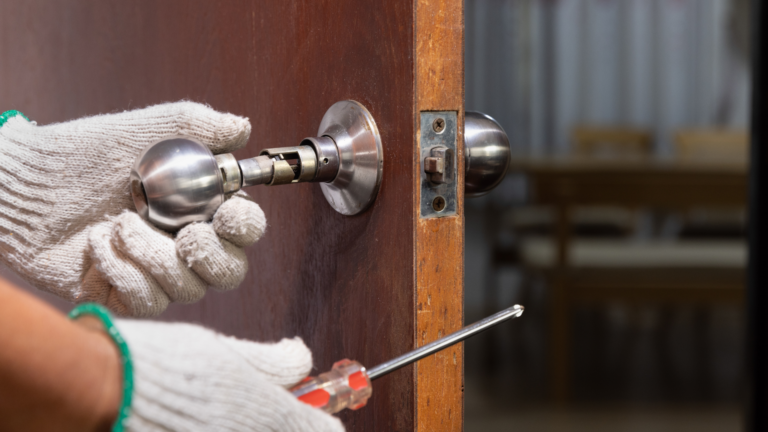Locks play an essential role in home security, yet they can face problems that compromise their effectiveness. Promptly addressing these issues is crucial for maintaining your home’s safety. In this section, we delve into prevalent lock problems, providing thorough insights and further solutions to keep your locks in optimal shape.
Locks That Are Hard to Rotate or Sticky
Causes
The primary reasons for lock malfunctions include the accumulation of debris, formation of rust, and worn-out internal components. Over time, dust and dirt can build up inside the lock mechanism, impeding its operation. Rust buildup can result from moisture exposure, particularly in older locks or those left outside. Furthermore, frequent use can erode the interior parts, which exacerbates lock problems.
Thorough Solutions
Disassemble the lock if you’re comfortable with the process and use a gentle brush and suitable cleaner to thoroughly clean the internal components, removing built-up debris and old lubricant. To prevent lock malfunctions, regularly lubricate the locks and maintain cleanliness in the surrounding area to keep debris out.
Locks and Striker Plates Out of Alignment
Causes
Doors and frames may shift over time due to structural settling in buildings. Furthermore, weather variations might cause materials to expand and contract, which could lead to misaligned doors and frames.
Thorough Solutions
To properly realign a door, use a screwdriver to tighten the hinges and adjust shims as needed. If the latch doesn’t align with the strike plate, remove and reinstall it in the correct position, possibly requiring chiseling for new space. In addition, changing or replacing the weather stripping ensures that the door closes smoothly, fits snugly in its frame, and avoids misalignment problems in the future.
Keys with Breakage
Causes
With frequent use or exposure to force, keys can develop weak points over time, compromising their integrity. In addition, continuous use leads to metal wear and tear, heightening the likelihood of breakage.
Thorough Solutions
Removing a broken key from a lock involves using a key extractor tool or a small jigsaw blade to carefully catch and extract the broken piece. It’s wise to check keys for wear periodically and have duplicates made before they wear down too much. It’s advisable to refrain from using heavily worn keys to prevent breakage. If you face difficulty removing the broken key, consider contacting a locksmith who can safely extract it using specialized tools.
Locks with Wobble or Looseness
Causes
Locks in high-traffic areas often loosen due to frequent use, which wears down their mechanisms over time. Improperly installed locks can also loosen over time if they were not securely fastened initially.
Thorough Solutions
Start by removing the cover and tightening all visible screws to maintain the lock’s functionality. Ensure the lock mechanism is securely attached to the door. Furthermore, if you notice any worn-out components, replacing the entire lock mechanism may be required to ensure its effectiveness.
Need a locksmith? Don't Worry!
Our expert locksmiths are available 24/7. We're here to help with all your emergency lock needs. Don't hesitate, call us now!
Key Won’t Insert Fully
Causes
Debris or foreign objects can block the keyway, causing disruptions in the smooth operation of the lock. Also, a bent or damaged key may pose a barrier to full insertion, compromising the lock’s functionality. It’s crucial to promptly address both issues to ensure smooth key operation and secure the lock.
Thorough Solutions
Begin by using a thin, non-metallic tool to clear any visible debris from the keyway for proper lock operation. Then, carefully check the key for bends or damage; replace it with a new one if required to prevent further issues. If the problem persists, consider getting in touch with knowledgeable residential locksmiths in Akron, OH. To ensure maximum security and functionality, they could thoroughly inspect and clean the inside components of the lock.
Lock is Frozen
Causes
When temperatures decrease, moisture inside a lock can freeze, affecting its operation. The performance of locks exposed to severe weather can be hampered by freezing, which is less likely to occur with proper weatherproofing. Adequately protecting locks from the elements is crucial to prevent moisture buildup and freezing.
Thorough Solutions
For rapid thawing of a frozen lock, apply a lock de-icer spray containing alcohol or similar substances known for effective ice melting. Before the cold season, applying a lubricant helps to repel moisture, while installing a lock cover protects against harsh weather conditions. Should the lock remain frozen, heat the key gently with warm water or a lighter before using it to melt the ice inside the lock.
Homeowners can keep their locks secure and functional by promptly dealing with common issues and understanding when professional assistance is required. A home’s locking systems must be properly cared for, updated on schedule, and maintained consistently to remain reliable and intact.
If you’re experiencing problems with your home’s locks and need a solution, consider contacting residential locksmiths in Akron, OH. Using our expertise and specialized tools, we address a variety of lock-related issues to improve property security and provide peace of mind. Call us today without delay!

